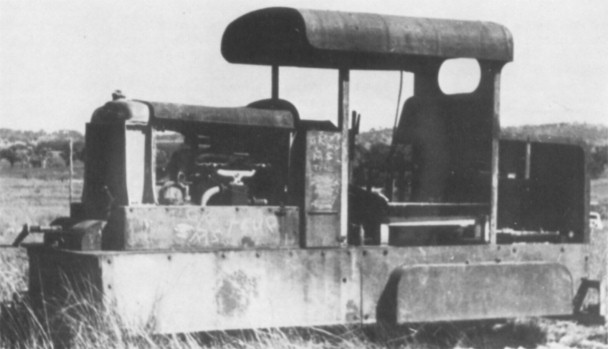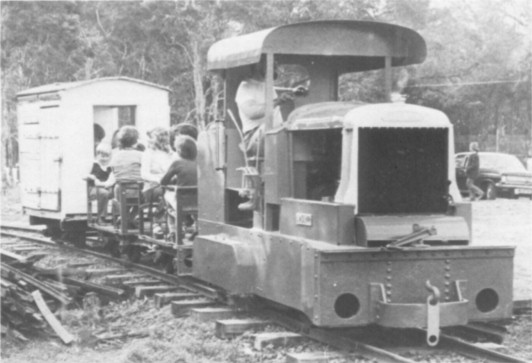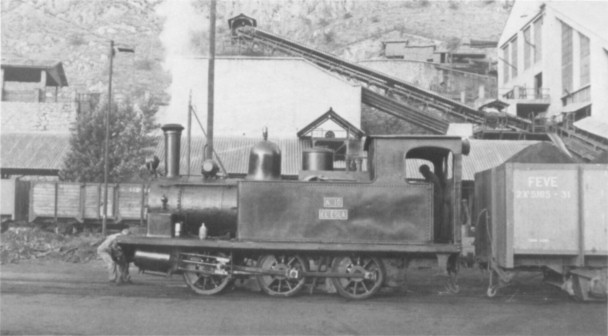
| THE INDUSTRIAL RAILWAY RECORD |
© DECEMBER 1982 |
KRAUSS 2179
K. McCARTHY
Charles S. Small gave a brief account of the history of Krauss 2179 of 1889 on page 126 of RECORD 62, but since that date further information has been obtained which has enabled this expanded story to be presented. Contrary to the popular belief that the loco was scrapped in 1958, it is very much in use at the Illawarra Light Railway Museum at Albion Park near Wollongong, on the south coast of New South Wales.
Krauss 2179, a 2ft 0in gauge 0‑4‑0 well tank with 63/8in x 12in outside cylinders, was imported into Victoria by contractor John Robb during 1889. This 5½ ton engine was imported through Schadler & Koniger of Queen Street, Melbourne, together with numbers 2178, 2180, 2181, 2195 and 2196. These were used on Robb's contract to expand port facilities on the Yarra River, plus associated swamp reclamation work adjacent to the main Spencer Street railway station. Between about 1893 and 1896 the six Krauss locomotives were involved in the construction of the Happy Valley water scheme to the south east of Adelaide, near Clarendon. On the completion of this work the locos were dispersed to separate projects.
The location of 2179 between 1896 and 1910 has yet to be confirmed, but some researchers believe that it was employed in a quarry near Broken Hill in the western arid region of New South Wales. However, from 1910 to 1931 this engine was observed working on cutting, embankment and tunnel work on New South Wales Government Railway (NSWGR) constructions. Between 1910 and 1913 it was used by Norton Griffith, a major railway contractor of that period, while during the following years the Krauss was used on the Coonabarabran to Gwabegar, and the Macksville to Kempsey, extensions.
The Krauss was taken over by the NSWGR after 1917, possibly from private contractors, and received number LO.43 in the roster generally occupied by non revenue earning motive power involved in construction or loco depot/workshop service. NSWGR records reveal that LO.43 was overhauled at the Eveleigh (Sydney) workshops during 1919 and 1922, while in August 1924 it received number 1024 in the new unified NSWGR scheme. Further dates which emerge from NSWGR records reveal that the Krauss received internal boiler examinations at the Water Supply Works of the NSWGR Chullora Workshops between May and August 1926, and it was shown stored at the NSWGR Clyde Workshops in December 1931 with a retubed boiler.

The Leyland engined Krauss 2179 stands disused at Home Rule Quarry in 1973. (R. Frier)

The fully restored Krauss 2179 operating at the ILRM site on 13th June 1976, following the naming ceremony. (K. McCarthy)
On 8th June 1936 Krauss 2179 was sold to W. West, who later that year resold it to Newbold Silica & Firebrick Co. They transferred the unit to their railway which linked a jetty at Bannister Point to Pattimore silica quarry, near Milton, on the south coast of New South Wales. This railway had opened in February 1925 with petrol or diesel locos as motive power, but during 1938 the firm's main quarrying efforts were transferred to their Red Head (Bendalong) deposits some ten miles north of Pattimore. It seems that at this stage the Krauss was transferred to the Newbold works at Thirroul, near Wollongong, New South Wales, where it was converted to a petrol loco by fitting a World War 1 Leyland four cylinder lorry engine.
The location of this Krauss/Leyland unit over the next seven years is somewhat of a mystery. The petrol and diesel locos on the Bannister Point line were apparently used at Red Head after 1938. Interviews with Newbold employees seem to suggest that the Krauss/Leyland shunted side tipping wagons on the clay pit tracks at Thirroul during that period. During 1949 a four-wheel loco powered by a Vulcan petrol lorry engine was observed at Thirroul, but by 1953 this track had been lifted and the Vulcan was photographed abandoned near the brickworks.
During 1945 the Newbold General Refractories Company expanded the workings at the Home Rule quarries near Gulgong, and the Krauss/Leyland was introduced to haul trucks on the quarry railway. Home Rule is located on the Gulgong-Mudgee goldfields which boomed during the 1870's; from 1931 the region developed into a major source of kaolin clay. Motor lorries replaced the railway operation at the Home Rule Quarry in 1946, although some rail handling was reintroduced during 1947. However, it is possible that the locomotive saw no further use.
In 1973 the now partially dismantled Krauss/Leyland loco was donated to the Illawarra Light Railway Museum (ILRM) by the Newbold undertaking for preservation and restoration. While negotiations were being carried out concerning transportation of the relic over the three hundred miles to Albion Park, a local folk museum removed the locomotive from Home Rule during May or June 1974. However, with the justification that the loco had spent some time working in the south coast area of New South Wales, the ILRM initiated legal action to recover the loco, and the unit arrived at Albion Park on 18th June 1975. The loco was in poor condition but was stripped for overhaul and it was during this process that the Krauss identification of the relic was revealed! An energetic railway fitter had luckily engraved the number 1024 with a cold chisel on the front buffer beam, and this initiated the research which has resulted in this article being prepared.
Local industry and kindred societies thereafter assisted in the restoration of the relic: the metallurgy laboratory of the Port Kembla Steel Works helped with the reconstruction of the badly damaged aluminium radiator header tank; a Sydney firm restored the cylinder blocks by the Metal-Lock process; the Fire Engine Society provided the replacement for the missing magneto; and so, on 3rd April 1976, the assembled motor again fired to life after twenty years inactivity. Running trials were undertaken on 10th April 1976, and the fully restored unit was returned to museum operation on 13th June 1976 when Mr Sid Wearne, a retired manager of the Newbold plant, performed the ceremony of unveiling the NEWBOLD nameplates on the locomotive.
Finally, the ILRM heard that the original Krauss builder's plate had been rediscovered. It seems that in the 1960's a piece of metal was found protruding from the ground at the Macksville, New South Wales, railway goods yard, and when freed, was found to be the missing builder's plate. The owner lent it to various people to enable copy plates to be made, but when the ILRM finally was able to borrow the plate in 1979, it was realised that a poor copy had been exchanged for the original somewhere along the line. Fortunately the Light Railway Museum has access to a high class professional foundry, and with considerable cosmetic work, a copy approaching the original plate quality was manufactured, and this is now on display at the Albion Park Museum.

A cast off from the metre gauge Carinena-Zaragoza railway, No.10 EL ESLA (Sharp Stewart 3343 of 1885) was still at work on 31st July 1978 at the Sabero Gaol mine near Cistierna in northern Spain.
(S.M.N. Grudgings)